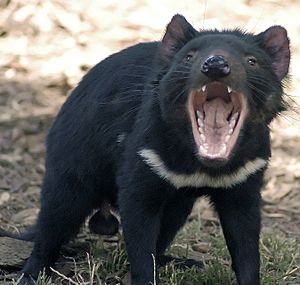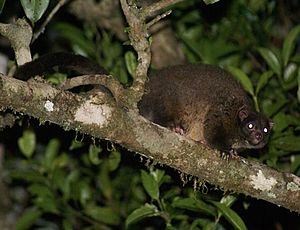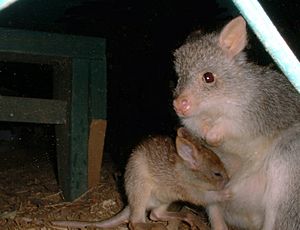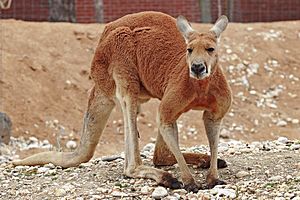List of monotremes and marsupials of Australia facts for kids
Mammals are incredible animals, and they are grouped based on how they reproduce. One group is the monotremes, which are special because they lay eggs, just like birds or reptiles! The other big group of mammals gives birth to live young. This group is then split into two more: marsupials, who carry their babies in a pouch, and placental mammals, whose babies grow inside their mother with a special organ called a placenta.
Australia is a unique place because it's home to two of the five known types of monotremes in the world. It also has most of the world's marsupials! You can find other marsupials in places like Papua New Guinea, eastern Indonesia, and the Americas. This list focuses on these special Australian mammals.
This article is a smaller part of the main list of mammals of Australia.
Scientists keep track of how many animals are left in the wild. This helps us know which ones need our help to survive. Here are the different conservation statuses:
- extinct - sadly, none are left anywhere in the world.
- extinct in the wild - they only exist in zoos or special breeding programs.
- critically endangered - they are very close to becoming extinct.
- endangered - they are at high risk of extinction.
- vulnerable - they are at risk of becoming endangered.
- near threatened - they might become vulnerable soon.
- least concern - they are doing well and are not currently at risk.
- data deficient - we don't have enough information to know their status.
- not evaluated - their status hasn't been checked yet.
Contents
|
Monotremes: Egg-Laying Mammals
Monotremes are super unique mammals because, unlike most mammals, they lay eggs! Once the eggs hatch, the tiny babies drink milk from their mother, just like other mammals. Australia is lucky to have two of the world's living monotreme species.
Ornithorhynchidae: The Platypus Family
- Platypus, Ornithorhynchus anatinus
* The platypus is an amazing animal with a duck-like bill, webbed feet, and a beaver-like tail. It lives in rivers and streams.
Tachyglossidae: The Echidna Family
- Short-beaked echidna, Tachyglossus aculeatus
* Echidnas are spiny anteaters. They have long snouts and sticky tongues to catch ants and termites.
Marsupials: Pouched Mammals
Marsupials are famous for carrying their young in a pouch! When a marsupial baby is born, it's very tiny and undeveloped. It then crawls into its mother's pouch to continue growing and drinking milk. Australia has a huge variety of marsupials, from tiny mouse-like creatures to giant kangaroos.
Dasyuromorphia: Marsupial Carnivores
This group includes many meat-eating marsupials. They range from small, mouse-like animals to larger predators.
Thylacinidae: The Thylacine Family
- Thylacine, Thylacinus cynocephalus - extinct
* Also known as the Tasmanian tiger, this striped animal was a large predator. Sadly, it is now extinct.
Dasyuridae: Quolls and Devils
This family includes many small to medium-sized carnivorous marsupials. They are often active hunters.
- Tropical antechinus, Antechinus adustus
- Agile antechinus, Antechinus agilis
- Fawn antechinus, Antechinus bellus
- Yellow-footed antechinus, Antechinus flavipes
- Atherton antechinus, Antechinus godmani
- Cinnamon antechinus, Antechinus leo
- Swamp antechinus, Antechinus minimus
- Brown antechinus, Antechinus stuartii
- Subtropical antechinus, Antechinus subtropicus
- Dusky antechinus, Antechinus swainsonii
- Brush-tailed mulgara, Dasycercus blythi
- Crest-tailed mulgara, Dasycercus cristicauda
- Kaluta, Dasykaluta rosamondae
- Kowari, Dasyuroides byrnei
- Western quoll, Dasyurus geoffroii
- Northern quoll, Dasyurus hallucatus
- Tiger quoll, Dasyurus maculatus
- Eastern quoll, Dasyurus viverrinus
- Wongai ningaui, Ningaui ridei
- Pilbara ningaui, Ningaui timealeyi
- Mallee ningaui, Ningaui yvonneae
- Dibbler, Parantechinus apicalis
- Red-tailed phascogale, Phascogale calura
- Brush-tailed phascogale, Phascogale tapoatafa
- Brush-tailed phascogale, Phascogale (tapoatafa) pirata
- Kultarr, Antechinomys laniger
- Paucident planigale, Planigale gilesi
- Long-tailed planigale, Planigale ingrami
- Common planigale, Planigale maculata
- Narrow-nosed planigale, Planigale tenuirostris
- Sandstone false antechinus, Pseudantechinus bilarni
- Fat-tailed false antechinus, Pseudantechinus macdonnellensis
- Alexandria false antechinus, Pseudantechinus mimulus
- Ningbing false antechinus, Pseudantechinus ningbing
- Rory Cooper's false antechinus, Pseudantechinus roryi
- Woolley's false antechinus, Pseudantechinus woolleyae
- Tasmanian devil, Sarcophilus harrisii
- Fat-tailed dunnart, Sminthopsis crassicaudata
- Kakadu dunnart, Sminthopsis bindi
- Carpentarian dunnart, Sminthopsis butleri
- Julia Creek dunnart, Sminthopsis douglasi
- Stripe-faced dunnart, Sminthopsis macroura
- Red-cheeked dunnart, Sminthopsis virginiae
- White-tailed dunnart, Sminthopsis granulipes
- Kangaroo Island dunnart, Sminthopsis aitkeni
- Grey-bellied dunnart, Sminthopsis griseoventer (including S. (griseoventer) boullangerensis: )
- Boullanger Island dunnart, Sminthopsis boullangerensis (formerly S. griseoventer boullangerensis)
- Long-tailed dunnart, Sminthopsis longicaudata
- Chestnut dunnart, Sminthopsis archeri
- Little long-tailed dunnart, Sminthopsis dolichura
- Sooty dunnart, Sminthopsis fuliginosus
- Gilbert's dunnart, Sminthopsis gilberti
- White-footed dunnart, Sminthopsis leucopus
- Slender-tailed dunnart, Sminthopsis murina
- Hairy-footed dunnart, Sminthopsis hirtipes
- Ooldea dunnart, Sminthopsis ooldea
- Sandhill dunnart, Sminthopsis psammophila
- Lesser hairy-footed dunnart, Sminthopsis youngsoni
Myrmecobiidae: The Numbat Family
- Numbat, Myrmecobius fasciatus
* The numbat is a unique marsupial that eats termites. It has a long, sticky tongue to catch its prey.
Peramelemorphia: Bandicoots and Bilbies
This group includes bandicoots and bilbies, which are small to medium-sized marsupials. They often have long snouts and strong claws for digging.
Chaeropodidae: The Pig-footed Bandicoot Family
- Pig-footed bandicoot, Chaeropus ecaudatus - extinct
* This unusual bandicoot had very slender limbs. It is now extinct.
Peroryctidae: The Spiny Bandicoot Family
- Rufous spiny bandicoot, Echymipera rufescens
Peramelidae: True Bandicoots
- Golden bandicoot, Isoodon auratus
- Northern brown bandicoot, Isoodon macrourus
- Southern brown bandicoot, Isoodon obesulus
- Western barred bandicoot, Perameles bougainville
- Desert bandicoot, Perameles eremiana - extinct
- Eastern barred bandicoot, Perameles gunnii
- Long-nosed bandicoot, Perameles nasuta
Thylacomyidae: The Bilby Family
- Bilby, Macrotis lagotis
* Bilbies are desert-dwelling marsupials with long ears and a pointed snout. They are excellent diggers.
- Lesser bilby, Macrotis leucura - extinct
Notoryctemorphia: Marsupial Moles
These are very special marsupials that live underground. They are blind and have adapted to a digging lifestyle.
Notoryctidae: The Marsupial Mole Family
- Northern marsupial mole, Notoryctes caurinus
- Southern marsupial mole, Notoryctes typhlops
Diprotodontia: Kangaroos, Koalas, and Wombats
This is the largest group of marsupials and includes many well-known Australian animals. They are mostly plant-eaters.
Vombatiformes: Wombats and Koalas
This group contains the sturdy, ground-dwelling wombats and the tree-dwelling koalas.
Vombatidae: The Wombat Family
- Northern hairy-nosed wombat, Lasiorhinus krefftii
- Southern hairy-nosed wombat, Lasiorhinus latifrons
- Common wombat, Vombatus ursinus
* Wombats are strong, burrowing marsupials with a backward-facing pouch.
Phascolarctidae: The Koala Family
- Koala, Phascolarctos cinereus
* Koalas are iconic Australian animals that spend most of their lives in eucalyptus trees.
Phalangeriformes: Possums and Gliders
This group includes many tree-dwelling marsupials, some of which can glide through the air.
Phalangeridae: Brushtail Possums and Cuscuses
- Southern common cuscus, Phalanger mimicus
- Common spotted cuscus, Spilocuscus maculatus
- Northern brushtail possum, Trichosurus arnhemensis
- Short-eared possum, Trichosurus caninus
- Mountain brushtail possum, Trichosurus cunninghami
- Common brushtail possum, Trichosurus vulpecula
- Coppery brushtail possum, Trichosurus johnstonii
- Scaly-tailed possum, Wyulda squamicaudata
Burramyidae: Pygmy Possums
- Mountain pygmy possum, Burramys parvus
- Long-tailed pygmy possum, Cercartetus caudatus
- Southwestern pygmy possum, Cercartetus concinnus
- Tasmanian pygmy possum, Cercartetus lepidus
- Eastern pygmy possum, Cercartetus nanus
Tarsipedidae: The Honey Possum Family
- Honey possum, Tarsipes rostratus
* The honey possum is a tiny marsupial that feeds on nectar and pollen.
Petauridae: Gliding Possums
- Striped possum, Dactylopsila trivirgata
- Leadbeater's possum, Gymnobelideus leadbeateri
- Yellow-bellied glider, Petaurus australis
- Sugar glider, Petaurus breviceps
- Mahogany glider, Petaurus gracilis
- Squirrel glider, Petaurus norfolcensis
Pseudocheiridae: Ringtail Possums and Greater Gliders
- Lemuroid ringtail possum, Hemibelideus lemuroides
- Greater glider, Petauroides volans
- Rock ringtail possum, Petropseudes dahli
- Common ringtail possum, Pseudocheirus peregrinus
- Western ringtail possum, Pseudocheirus (peregrinus) occidentalis
- Green ringtail possum, Pseudochirops archeri
- Daintree River ringtail possum, Pseudochirulus cinereus
- Herbert River ringtail possum, Pseudochirulus herbertensis
Acrobatidae: The Feathertail Glider Family
- Feathertail glider, Acrobates pygmaeus
* This tiny possum has a special membrane that allows it to glide between trees.
Macropodiformes: Kangaroos, Wallabies, and Relatives
This large group includes the famous kangaroos and wallabies, known for their powerful hopping legs.
Hypsiprymnodontidae: The Musky Rat-Kangaroo Family
- Musky rat-kangaroo, Hypsiprymnodon moschatus
* This small marsupial is unique because it is active during the day.
Potoroidae: Bettongs and Potoroos
- Rufous bettong, Aepyprymnus rufescens
- Southern bettong, Bettongia gaimardi
- Burrowing bettong, Bettongia lesueur
- Woylie, Bettongia penicillata
- Northern bettong, Bettongia tropica
- Nullarbor dwarf bettong, Bettongia pusilla - extinct
- Desert rat-kangaroo, Caloprymnus campestris - extinct
- Gilbert's potoroo, Potorous gilbertii
- Long-footed potoroo, Potorous longipes
- Broad-faced potoroo, Potorous platyops - extinct
- Long-nosed potoroo, Potorous tridactylus
Macropodidae: Kangaroos and Wallabies
This family includes all the different types of kangaroos, wallabies, and their relatives.
- Bennett's tree-kangaroo, Dendrolagus bennettianus
- Lumholtz's tree-kangaroo, Dendrolagus lumholtzi
- Central hare-wallaby, Lagorchestes asomatus - extinct
- Spectacled hare-wallaby, Lagorchestes conspicillatus
- Mala, Lagorchestes hirsutus
- Eastern hare-wallaby, Lagorchestes leporides - extinct
- Banded hare-wallaby, Lagostrophus fasciatus
- Western grey kangaroo, Macropus fuliginosus
- Eastern grey kangaroo, Macropus giganteus
- Agile wallaby, Notamacropus agilis
- Black-striped wallaby, Notamacropus dorsalis
- Tammar wallaby, Notamacropus eugenii
- Toolache wallaby, Notamacropus greyi - extinct
- Western brush wallaby, Notamacropus irma
- Parma wallaby, Notamacropus parma
- Whiptail wallaby, Notamacropus parryi
- Red-necked wallaby, Notamacropus rufogriseus
- Bridled nail-tail wallaby, Onychogalea fraenata
- Crescent nail-tail wallaby, Onychogalea lunata - extinct
- Northern nail-tail wallaby, Onychogalea unguifera
- Antilopine kangaroo, Osphranter antilopinus
- Black wallaroo, Osphranter bernardus
- Common wallaroo or euro, Osphranter robustus
- Red kangaroo, Osphranter rufus
- Allied rock-wallaby, Petrogale assimilis
- Short-eared rock-wallaby, Petrogale brachyotis
- Monjon, Petrogale burbidgei
- Cape York rock-wallaby, Petrogale coenensis
- Nabarlek, Petrogale concinna
- Godman's rock-wallaby, Petrogale godmani
- Herbert's rock-wallaby, Petrogale herberti
- Unadorned rock-wallaby, Petrogale inornata
- Black-flanked rock-wallaby, Petrogale lateralis
- Purple-necked rock-wallaby, Petrogale purpureicollis
- Mareeba rock-wallaby, Petrogale mareeba
- Brush-tailed rock-wallaby, Petrogale penicillata
- Proserpine rock-wallaby, Petrogale persephone
- Rothschild's rock-wallaby, Petrogale rothschildi
- Sharman's rock-wallaby, Petrogale sharmani
- Yellow-footed rock-wallaby, Petrogale xanthopus
- Quokka, Setonix brachyurus
- Tasmanian pademelon, Thylogale billardierii
- Red-legged pademelon, Thylogale stigmatica
- Red-necked pademelon, Thylogale thetis
- Swamp wallaby, Wallabia bicolor
See also





